Dr Julian Mauricio Londono Monsalve
Lecturer in Mechanical Engineering (E&R)
J.Londono-Monsalve@exeter.ac.uk
(Streatham) 3531
01392 723531
Overview
I am a Lecturer in Mechanical Engineering and the programme lead for the MSc in Mechanical Engineering at the University of Exeter. I am an expert in experimental nonlinear dynamics.
Research interests
- Vibration-based nonlinear system identification
- Experimental dynamics, Modal Testing and Real-Time Hybrid Testing (Hardware in-the-loop)
- Structural dynamics
- Modelling and simulation of nonlinear dynamical systems
- Structural control and vibration suppression
Short Bio
I received the prestigious 2020 Doak Prize from Elsevier for the most successful publication in the Journal of Sound and Vibration (JSV) in 2019. JSV is one the most respected Journals in the field of Experimental Nonlinear Dynamics.
My work with co-workers Profs. Marsico and Craciun on Graphene-Rubber Composites was ranked top 100 in the global 2020 Create the Future Design Contest sponsored by Intel, COMSOL, HP, Nvidia among others.
I was awarded a MEng cum laude in Civil Engineering in 2000 and MSc in Industrial Automation in 2006 from the National University of Colombia. Funded by a prestigious AlBan scholarship, I completed my PhD in Structural Engineering in 2010 at the University of Naples Federico II in Italy. I was involved in the research executive project RELUIS, a consortium of seismic engineering laboratories of Italian universities, where I worked on passive and semi-active control strategies (MR dampers) for vibration suppression of buildings. In collaboration with the industrial partner STRAGO srl., I also implemented and successfully tested a monitoring system able to detect and locate damages throughout an array of sensors based on Micro-Electro-Mechanical-Systems (MEMS).
I was awarded a prestigious Newton International Fellowship in 2010 from the Royal Academy of Engineering and the Royal Society to fund my work on developing more efficient damping systems and joined the Department of Mechanical Engineering at the University of Bristol. I was later appointed as a Research Associate in Nonlinear Dynamics, as a part of a multidisciplinary research team working in the Engineering Nonlinearity Programme Grant funded by the EPSRC, this embraced 5 top-class universities in the UK and 8 industrial partners including Airbus, Rolls-Royce, EDF energy among others.
 https://orcid.org/0000-0001-5501-8839
https://orcid.org/0000-0001-5501-8839
Publications
Copyright Notice: Any articles made available for download are for personal use only. Any other use requires prior permission of the author and the copyright holder.
| 2024 | 2023 | 2022 | 2021 | 2020 | 2018 | 2017 | 2016 | 2015 | 2014 | 2013 | 2011 | 2010 | 2001 |
2024
- Tian B, Yin S, Liu Y, Monsalve JL. (2024) Nonlinear characteristics identification of an impact oscillator with a one-sided elastic constraint, Journal of Sound and Vibration, pages 118270-118270, article no. 118270, DOI:10.1016/j.jsv.2024.118270. [PDF]
- Safari S, Londoño Monsalve JM. (2024) Importance of Virtual Sensing and Model Reduction in the Structural Identification of Bolted Assemblies, Conference Proceedings of the Society for Experimental Mechanics Series, pages 33-36, DOI:10.1007/978-3-031-36999-5_5.
2023
- Rivera ED, Londoño Monsalve J, Craciun MF, Marsico MR. (2023) Experimental Assessment of the Mechanical Performance of Graphene Nanoplatelets Coated Polymers, Advanced Engineering Materials, volume 25, no. 23, DOI:10.1002/adem.202300830.
- Safari S. (2023) Discovering physics-informed nonlinear dynamical models of engineering structures from vibration data.
- Safari S, Londoño Monsalve JM. (2023) Data-driven structural identification of nonlinear assemblies: Structures with bolted joints, Mechanical Systems and Signal Processing, volume 195, pages 110296-110296, article no. 110296, DOI:10.1016/j.ymssp.2023.110296. [PDF]
2022
- Londono Monsalve JM, Safari S. (2022) Physics-informed model Identification of structures with localised nonlinearities using machine learning, International Conference on Noise and Vibration Engineering-ISMA2022, Leuven, Belgium, 12th - 15th Sep 2022, ISBN 978-90-828931-5-1, pages 2511-2522.
- Marsico MR, Londoño Monsalve JM, Lu L, Craciun MF. (2022) The Effect of Graphene Ultrasonic Coating on Recycled Rubber, Advanced Engineering Materials, volume 24, no. 11, DOI:10.1002/adem.202200957. [PDF]
2021
- Safari S, Monsalve JL. (2021) Benchmarking Optimisation Methods for Model Selection and Parameter Estimation of Nonlinear Systems, Vibration, volume 4, no. 3, pages 648-665, DOI:10.3390/vibration4030036. [PDF]
- Safari S, Londoño Monsalve JM. (2021) Direct optimisation based model selection and parameter estimation using time-domain data for identifying localised nonlinearities, Journal of Sound and Vibration, volume 501, pages 116056-116056, article no. 116056, DOI:10.1016/j.jsv.2021.116056. [PDF]
2020
- Londono Monsalve JM, Marsico MR. (2020) Graphene-rubber layered composites for seismic isolatio, EURODYN 2020, Athens, Greece, 23rd - 26th Nov 2020, Proceedings of the XI International Conference on Structural Dynamics, EURODYN, volume 2, pages 3198-3203. [PDF]
- Marsico MR, Londoño Monsalve JM. (2020) GRAPHENE-RUBBER LAYERED COMPOSITES FOR SEISMIC ISOLATION, XI International Conference on Structural Dynamics, 23rd - 26th Nov 2020, XI International Conference on Structural Dynamics, DOI:10.47964/1120.9261.18988. [PDF]
- Jimenez Capilla JA, Londono Monsalve JM. (2020) Using Resonance Decay Responses to Model the Nonlinear Behaviour of Telecom Monopoles Via Backbone Curves, DOI:10.1007/978-3-030-47634-2_3. [PDF]
- Marsico MR, Londoño Monsalve JM. (2020) Graphene-Rubber Layered Functional Composites for Seismic Isolation, DOI:10.1007/978-3-030-47634-2_1. [PDF]
- Safari S, Londono Monsalve JM. (2020) Nonlinear Function Selection and Parameter Estimation of Structures with Localised Nonlinearities, Part 1: Numerical Analysis, DOI:10.1007/978-3-030-47626-7_23. [PDF]
- Marsico MR, Londoño Monsalve JM, Shin D-W, Craciun MF. (2020) Graphene–Rubber Layered Functional Composites for Seismic Isolation of Structures, Advanced Engineering Materials, volume 22, no. 7, DOI:10.1002/adem.201900852. [PDF]
2018
- Hoyos Velasco CI, Hoyos Velasco FE, Londoño Monsalve JM. (2018) Nonlinear Dynamics Analysis of a Dissipation System with Time Delay, International Journal of Bifurcation and Chaos, volume 28, pages 1830018-1830018, article no. 06, DOI:10.1142/S0218127418300185. [PDF]
- Losanno D, Londono JM, Zinno S, Serino G. (2018) Effective damping and frequencies of viscous damper braced structures considering the supports flexibility, Computers & Structures, volume 207, pages 121-131, DOI:10.1016/j.compstruc.2017.07.022. [PDF]
2017
- Londoño JM, Cooper JE, Neild SA. (2017) Identification of systems containing nonlinear stiffnesses using backbone curves, Mechanical Systems and Signal Processing, volume 84, pages 116-135, DOI:10.1016/j.ymssp.2016.02.008. [PDF]
2016
- Londono JM, Neild SA, Cooper JE. (2016) Systems with bilinear stiffness: Extraction of backbone curves and identification, Conference Proceedings of the Society for Experimental Mechanics Series, volume 1, pages 307-313, DOI:10.1007/978-3-319-15221-9_27.
- Caterino N, Georgakis CT, Luo N, Londono Monsalve J. (2016) Innovative Technologies for Reducing Structural Vibrations due to Natural Events and Human Activities, Shock and Vibration, volume 2016, pages 1-2, DOI:10.1155/2016/2181509. [PDF]
2015
- Losanno D, Zinno S, Serino G, Londono J. (2015) A design procedure in state-space representation for seismic retrofit of existing buildings with viscous dampers, Civil-Comp Proceedings.
- Losanno D, Zinno S, Serino G, Londono J. (2015) A design procedure in state-space representation for seismic retrofit of existing buildings with viscous dampers, Civil-Comp Proceedings, volume 108.
- Londoño JM, Neild SA, Cooper JE. (2015) Identification of backbone curves of nonlinear systems from resonance decay responses, Journal of Sound and Vibration, volume 348, pages 224-238, DOI:10.1016/j.jsv.2015.03.015.
- Londoño JM, Neild SA, Wagg DJ. (2015) Using a damper amplification factor to increase energy dissipation in structures, Engineering Structures, volume 84, pages 162-171, DOI:10.1016/j.engstruct.2014.11.019. [PDF]
2014
- Londoño JM, Cooper JE. (2014) Identification of a system containing geometric nonlinearities, Proceedings of the International Conference on Structural Dynamic , EURODYN, volume 2014-January, pages 2371-2376.
- Londono JM, Cooper JE. (2014) Experimental Identification of a System Containing Geometric Nonlinearities, DOI:10.1007/978-3-319-04753-9_26. [PDF]
- Londono JM, Cooper JE, Neild SA. (2014) Vibration testing of large scale nonlinear structures, Proceedings of ISMA 2014 - International Conference on Noise and Vibration Engineering and USD 2014 - International Conference on Uncertainty in Structural Dynamics, pages 1199-1210.
- Caterino N, Spizzuoco M, Londoño JM, Occhiuzzi A. (2014) Experimental Issues in Testing a Semiactive Technique to Control Earthquake Induced Vibration, Modelling and Simulation in Engineering, volume 2014, pages 1-11, DOI:10.1155/2014/535434. [PDF]
- Londoño JM, Wagg DJ, Neild SA. (2014) Supporting brace sizing in structures with added linear viscous fluid dampers: A filter design solution, Earthquake Engineering & Structural Dynamics, volume 43, no. 13, pages 1999-2013, DOI:10.1002/eqe.2433. [PDF]
2013
- Charmbalis G, Londono J, Cooper JE. (2013) Vibration testing of aeroelastic structures containing geometric stiffness nonlinearities, 54th AIAA/ASME/ASCE/AHS/ASC Structures, Structural Dynamics, and Materials Conference, DOI:10.2514/6.2013-1561.
- Charmbalis G, Londono J, Cooper JE. (2013) Vibration testing of aeroelastic structures containing geometric stiffness nonlinearities, Collection of Technical Papers - AIAA/ASME/ASCE/AHS/ASC Structures, Structural Dynamics and Materials Conference.
- Losanno D, Londono JM, Spizzuoco M. (2013) Structural monitoring system for the management of emergency due to natural events, 2013 IEEE Workshop on Environmental, Energy and Structural Monitoring Systems, EESMS 2013 - Proceedings, DOI:10.1109/EESMS.2013.6661703.
- Londoño JM, Neild SA, Wagg DJ. (2013) A noniterative design procedure for supplemental brace–damper systems in single‐degree‐of‐freedom systems, Earthquake Engineering & Structural Dynamics, volume 42, no. 15, pages 2361-2367, DOI:10.1002/eqe.2339. [PDF]
2011
- Hoyos CI, Londoño JM. (2011) Nonlinear dynamics analysis of a delayed system with hysteresis, Proceedings of the 8th International Conference on Structural Dynamics, EURODYN 2011, pages 1982-1989.
- Londoño JM, Serino G, di Bernardo M. (2011) Existence and stability of limit cycles in a delayed dry-friction oscillator, Nonlinear Dynamics, volume 67, no. 1, pages 483-496, DOI:10.1007/s11071-011-9997-2. [PDF]
- Londoño JM, Serino G, Wagg DJ, Neild SA, Crewe AJ. (2011) On the assessment of passive devices for structural control via real-time dynamic substructuring, Structural Control and Health Monitoring, volume 19, no. 8, pages 701-722, DOI:10.1002/stc.464. [PDF]
- Marsico M, Londoño JM, Neild SA, Wagg DJ. (2011) The effect of delay on real time dynamic substructuring tests in a cable for cable-stayed bridge, 4th Int. Conf. on Advances in Experimental Structural Eng, 1st - 1st Jan 2011.
2010
- Londoño JM, Serino G. (2010) Stability of delayed systems for substructuring testing applications, MOVIC 2010 - 10th International Conference on Motion and Vibration Control, Proceedings.
- Londoño JM, Serino G, Mannara G, Amura E, Autiero M, Barbati N. (2010) Use of MEMS-based sensors for local damage detection and monitoring, Proceedings of the 5th European Workshop - Structural Health Monitoring 2010, pages 806-811.
- Londoño JM, Serino G. (2010) Stability of delayed systems for substructuring testing applications, MOVIC 2010 - 10th International Conference on Motion and Vibration Control, Proceedings.
2001
- Hurtado JE, Londoño JM, Meza MA. (2001) On the applicability of neural networks for soil dynamic amplification analysis, Soil Dynamics and Earthquake Engineering, volume 21, no. 7, pages 579-591, DOI:10.1016/s0267-7261(01)00037-9. [PDF]
Further information
Research
My research work focuses on experimental testing and nonlinear dynamics of mechanical and aerospace structures. Much of my research interest is on modelling nonlinear vibrations using advanced numerical techniques and on developing reliable and efficient experimental testing methods to capture the dynamic response of components and assemblies of modern lightweight engineering structures behaving nonlinearly.
Vibration-based nonlinear system identification
Hybrid testing and nonlinear systems with time delay
Vibration mitigation and semiactive control
Vibration-based nonlinear system identification
- Development of effective techniques to extract backbone curves from the dynamic response of nonlinear systems, thus enabling their dynamic characterisation [JSV2016].
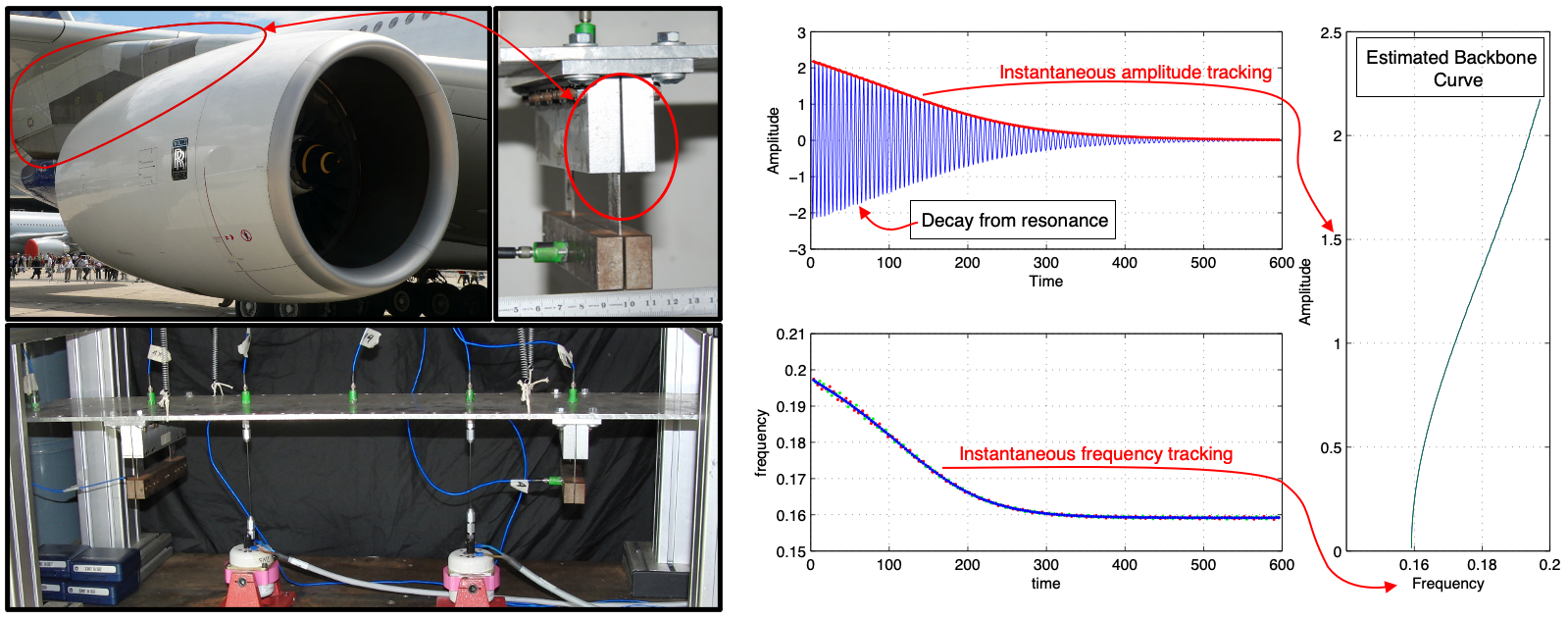
Figure 1. (left) setup of vibration test to study the pylon-engine nonlinear interaction. (right) Backbone curve estimation form the structure decaying response using zero-crossing and DSP tools.
- Developing methodologies for the experimental identification of nonlinear systems based on vibration data from resonance decay responses [MSSP2017]

Figure 2. (left) Experimental identification approach based on backbone curves. (right) Harmonic forced responses of identified system against experimentally measured backbone curves of real structure.
- Experimental identification of nonlinear systems from time domain data directly [JSV2021].
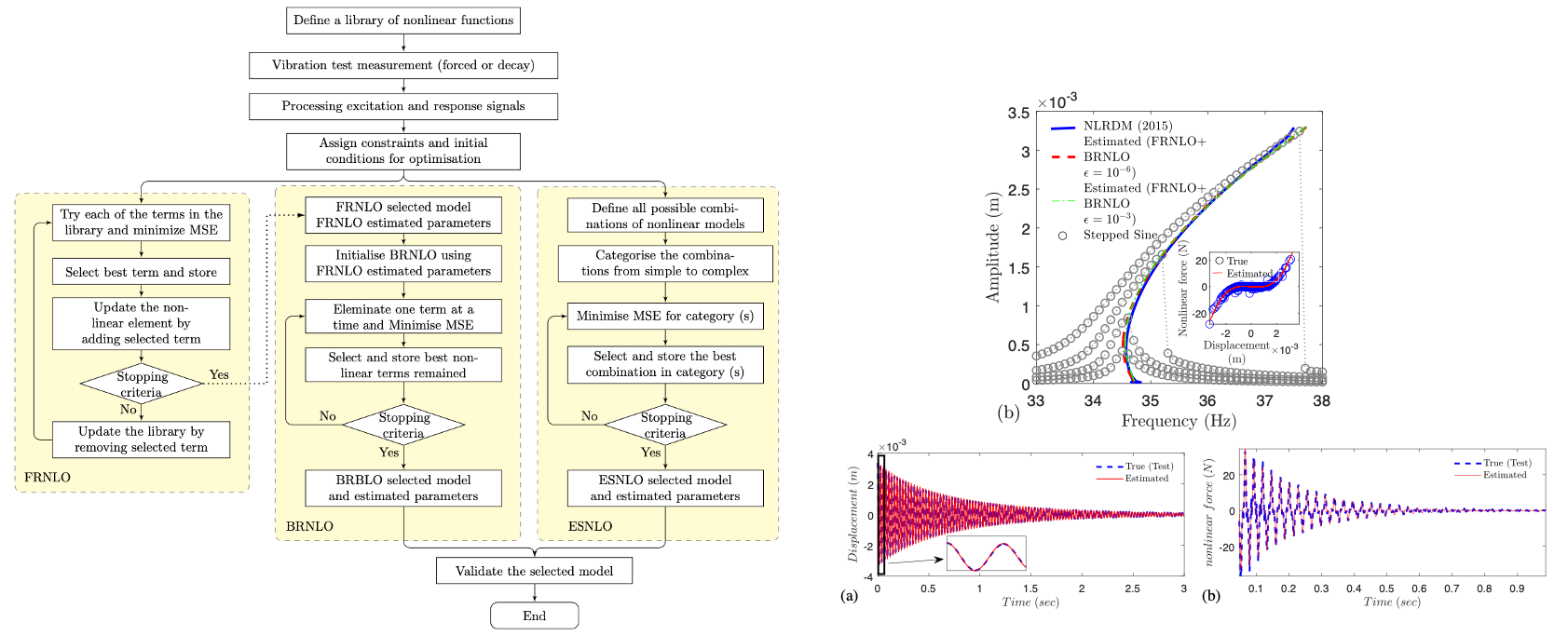
Figure 3. (left) Experimental identification approach via recursive optimization. (right) Harmonic and time-domain forced responses of real system against the prediction of the identified model.
- Joined wing: experimental identification of structures with geometric nonlinearites [AIAA2013].
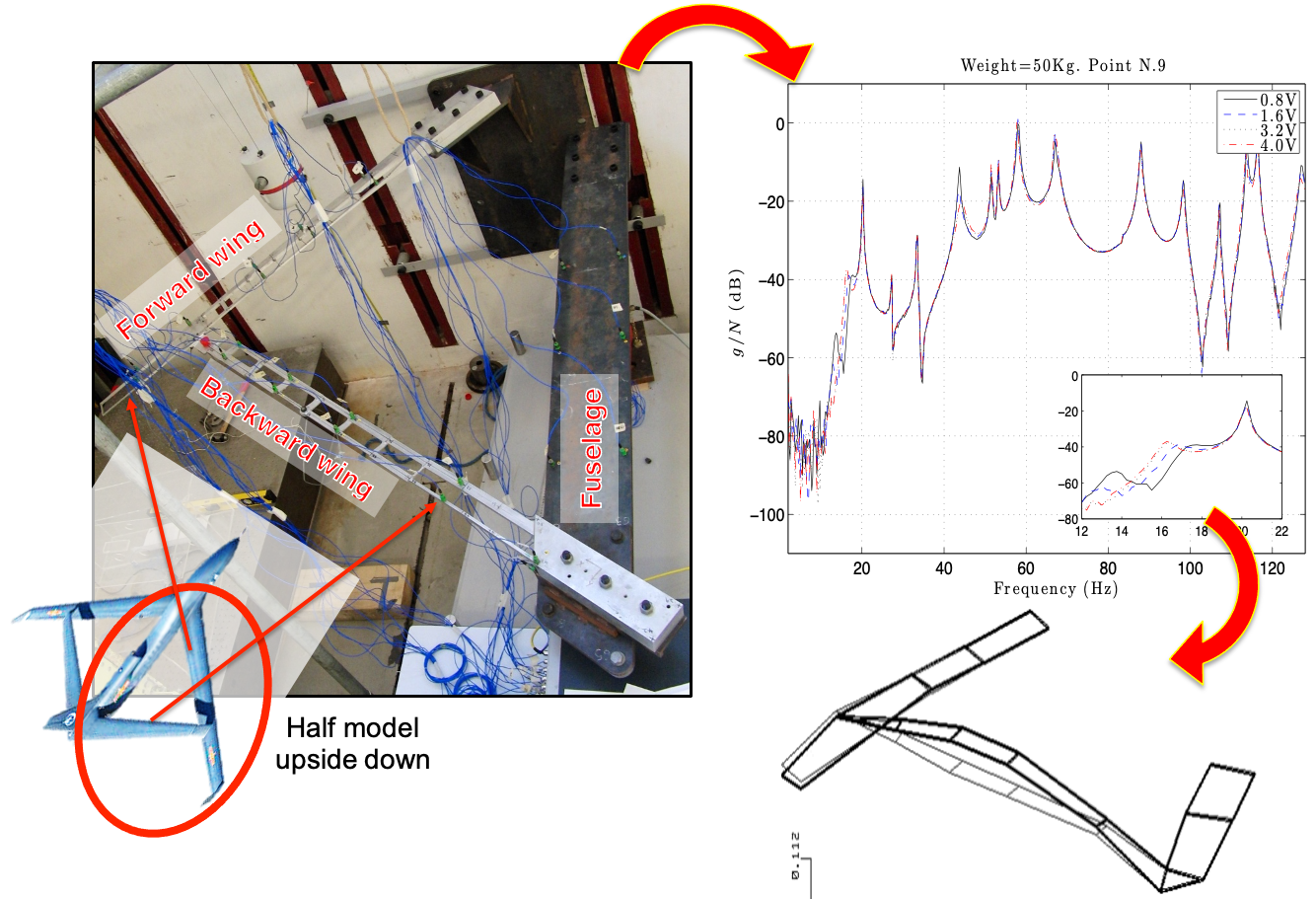 |
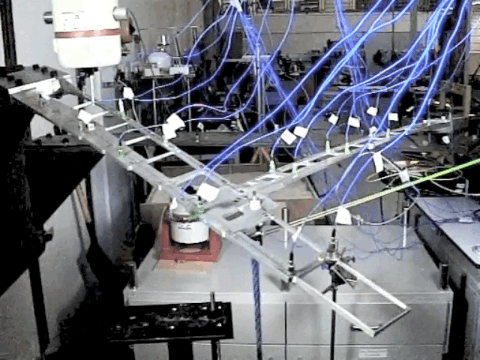 |
Figure 4. (left) Joined wing structure with geometric nonlinearities. (centre) Frequency shift due to nonlinearities and one of the vibration modes affected. (right) Slow motion video of a free decay test
Hybrid testing and nonlinear systems with time delay
- Implementation on delay compensation schemes for actuators in real-time dynamic substructuring (RTDS) testing using a prediction scheme based on adaptive filters [SCHM2011]. 
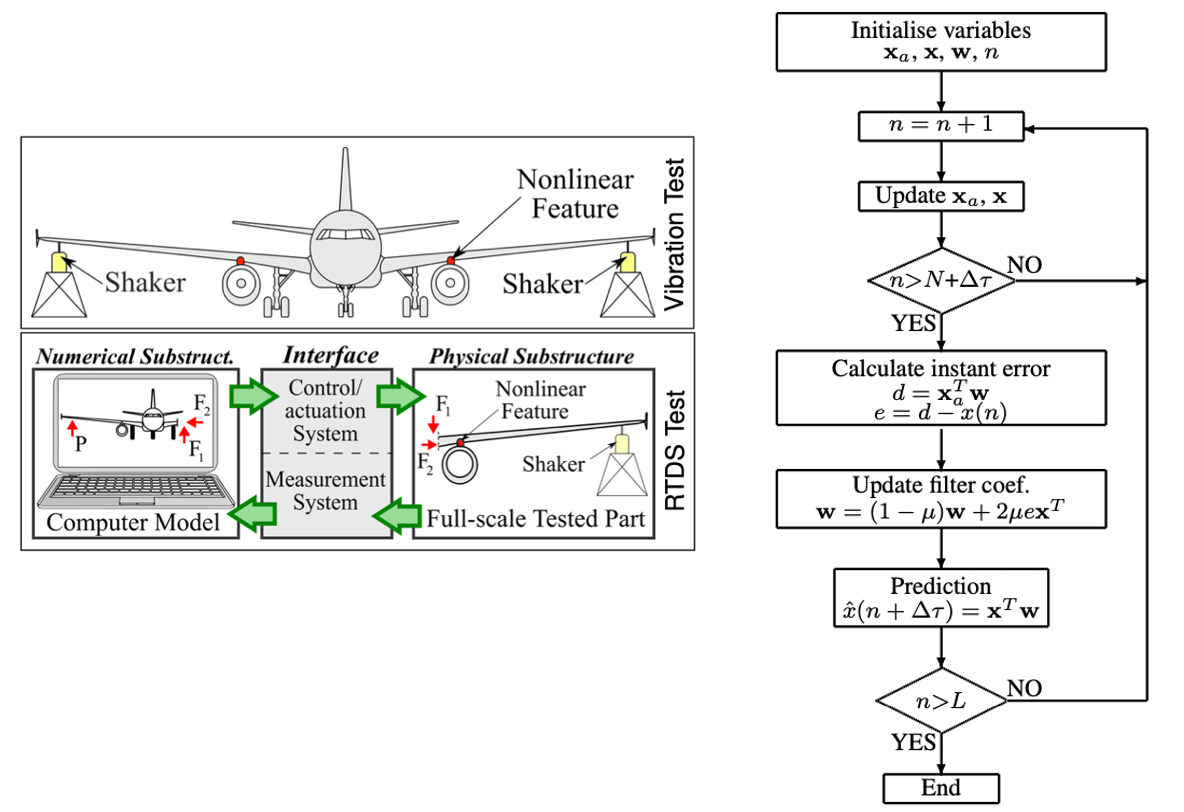
Figure 5. (left) setup of traditional vibration test compared to the equivalent RTDS configuration. (right) Flow diagram of prediction scheme.
- Stability study of delay-induced limit cycles in systems with strong nonlinear response using the qualitative theory of Piecewise Smooth Dynamical Systems [NonlinDyn]

Figure 6. (left) Vector field of the piecewise linear system with switching sets (right) delay-induced limit cycle characterisation.
- Characterisation of delay-induced phenomena triggered during RTDS testing of systems with nonlinear damping and friction [IJBC2018].

Figure 7. Bifurcation diagram considering time delay as the bifurcation parameter for the nonlinear system with hysteretic damping (Dhal model) shown on the right. Parameters: ρ =12, kx = 5.5 · 10−3, kw = {9; 15; 21} x10−3 for blue, green and black markers respectively.
- Use of RTDS to study the dynamic behaviour of buildings fitted with large-scale nonlinear dampers. 
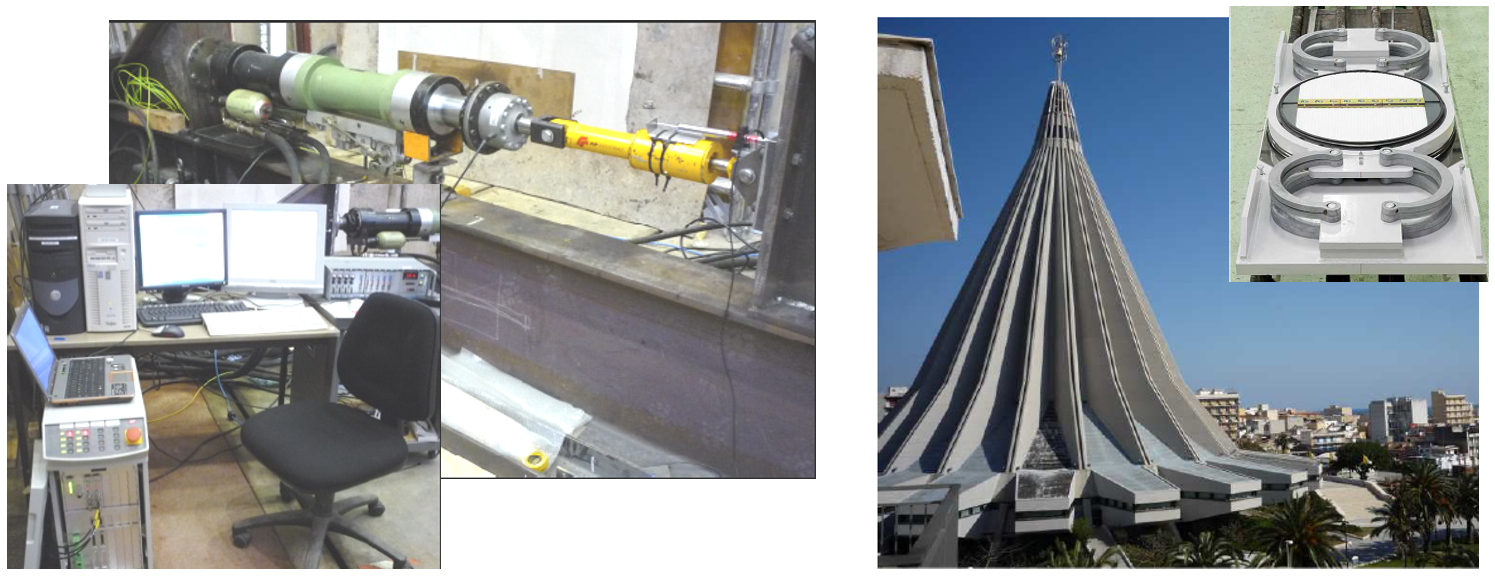
Figure 8. (left) RTDS on nonlinear viscous dampers. (right) An example of nonlinear seismic isolators used in a worship building in Syracuse (IT).
Vibration mitigation and semiactive control
- Novel non-iterative design procedures for passive damping systems aimed at facilitating their implementation among practitioner engineers.
- Design and testing of a damage detection/localisation system in railway bridges based on a network of wireless sensors.
- Use of Machine Learning strategies, in particular Neural Networks and Support Vector Machines, to model the soil dynamic amplification of earthquake waves and Research based design Optimisation.
- Development of novel control schemes for semi-active dampers aimed at reducing seismic loads on buildings.
Teaching
- ENG3015 - Structural Dynamics
- ENG3022 - Finite Element Analysis for high Value Manufacturing
- ENG2013 - Sustainable Design Challenge Project
- ECMM164 - MSc Dissertations
- ECM3175 - 3rd Year Individual Projects
Previous Modules
- ECM3173 - Structural Dynamics
- ECM3154 - Manufacturing (Additive Layer Manufacturing and Robotics)
- ECM2110 - Geotechnics I
- ECM2114 - Solid Mechanics
- ECM3152 - Computational Engineering (Computational Fluid Dynamcs)
- ECMM102 - 4th Year Group Projects
Project students and tutees
Please book here: Office hours booking system



